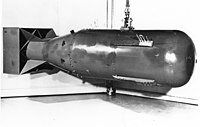
Photo from wikipedia
Polarization measurements have been widely used to detect aerosol properties by remote sensing in recent decades. To better understand the polarization characteristics of aerosols by lidar, the numerically exact T-matrix… Click to show full abstract
Polarization measurements have been widely used to detect aerosol properties by remote sensing in recent decades. To better understand the polarization characteristics of aerosols by lidar, the numerically exact T-matrix method was used to simulate the depolarization ratio (DR) of dust and smoke aerosols at typical laser wavelengths in this study. The results show that the DRs of dust and smoke aerosols have obviously different spectral dependences. Moreover, the ratio of DRs at two wavelengths has an obvious linear relationship with the microphysical properties of aerosols, including aspect ratio, effective radius and complex refractive index. At short wavelengths, we can use it to invert the absorption characteristics of particles, further improving the detection ability of lidar. Comparing the simulation results of different channels, DR, (color ratio) CR and (lidar ratio) LR have a good logarithmic fitting relationship at 532 nm and 1064 nm, which helps to classify the aerosol types. On this basis, a new inversion algorithm, "1β+1α+2δ", was presented. By this algorithm, the backscattering coefficient (β), extinction coefficient (α), DR (δ) at 532 nm and 1064 nm can be used to expand the range of inversion and compare lidar data with different configurations to obtain more extensive optical characteristics of aerosols. Our study enhances the application of laser remote sensing in aerosol observations more accurately.
Journal Title: Optics express
Year Published: 2023
Link to full text (if available)
Share on Social Media: Sign Up to like & get
recommendations!